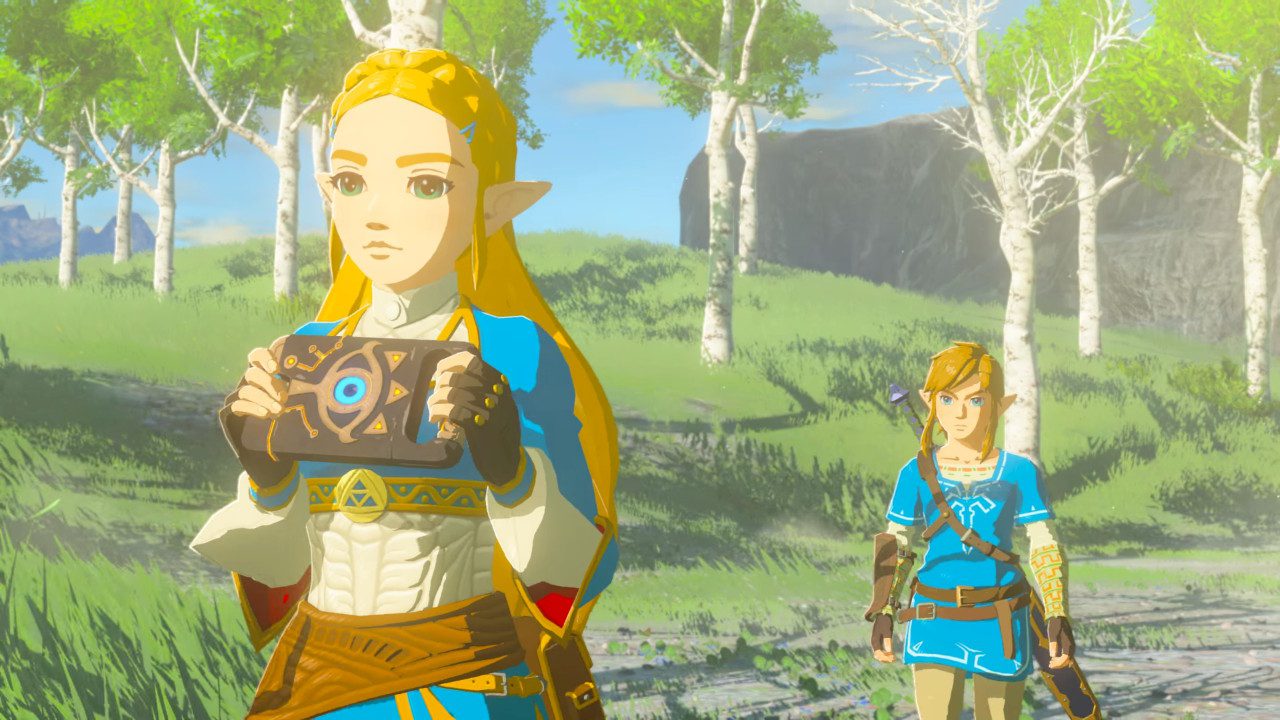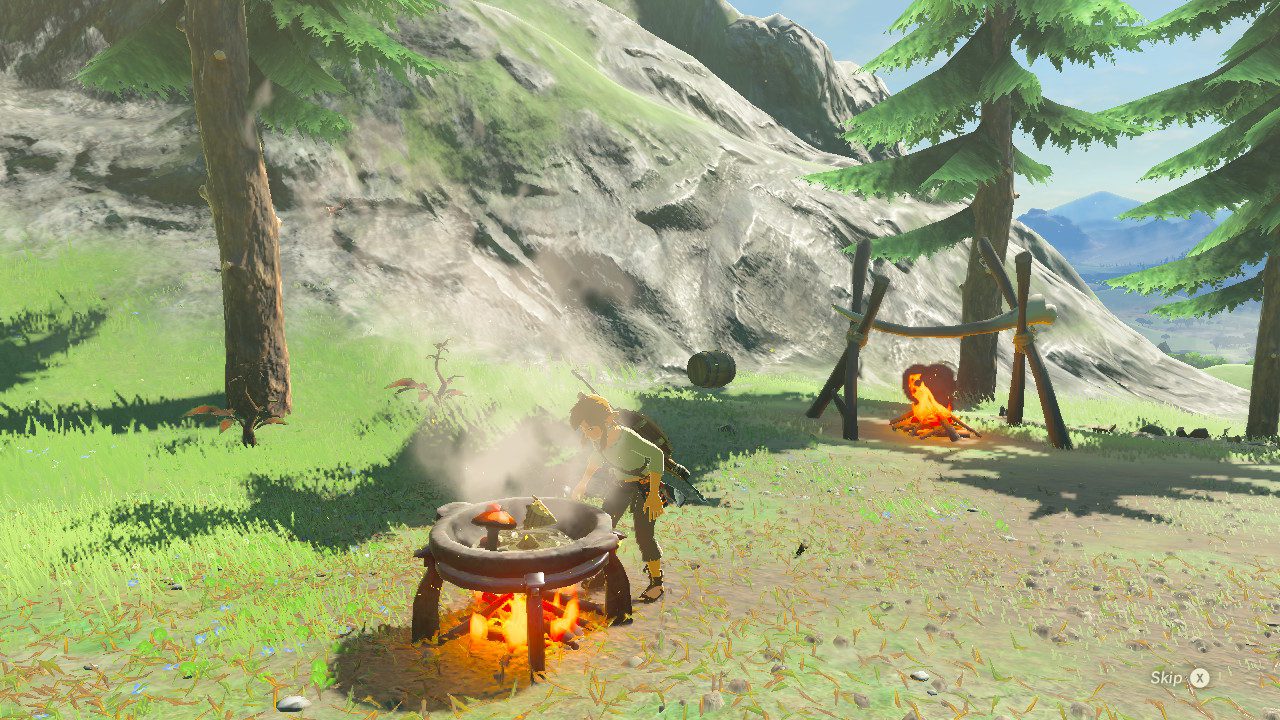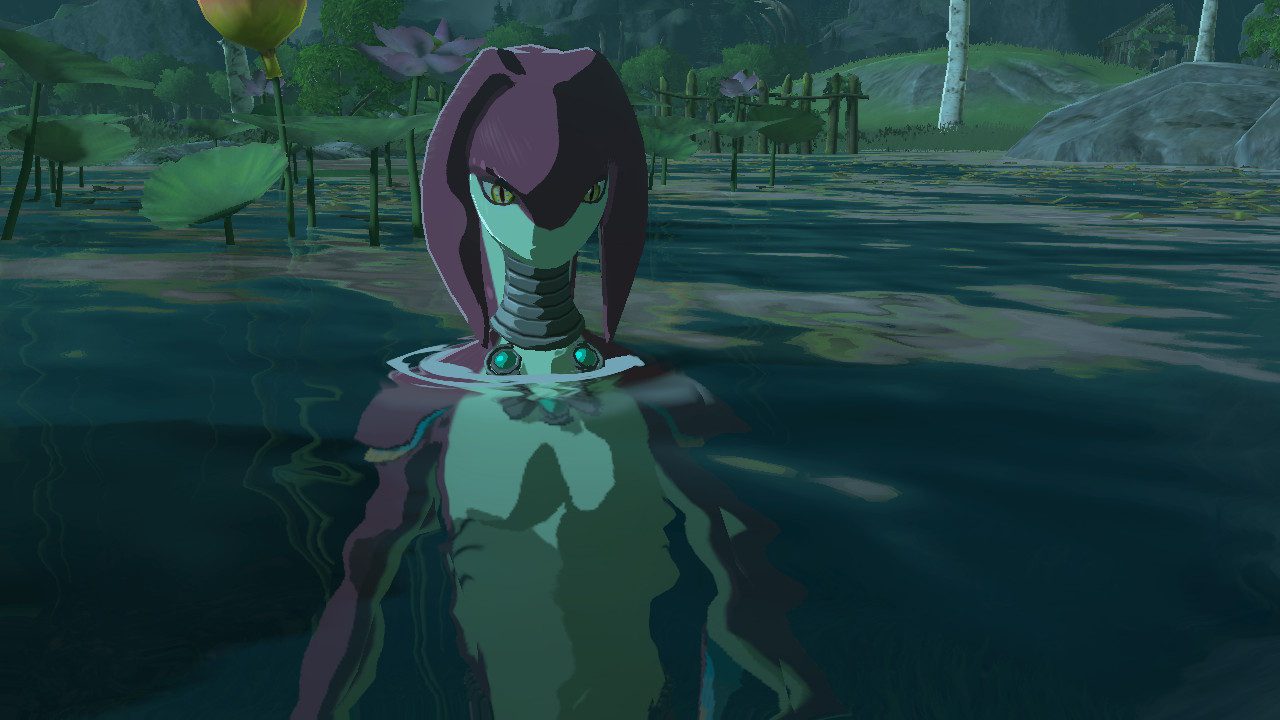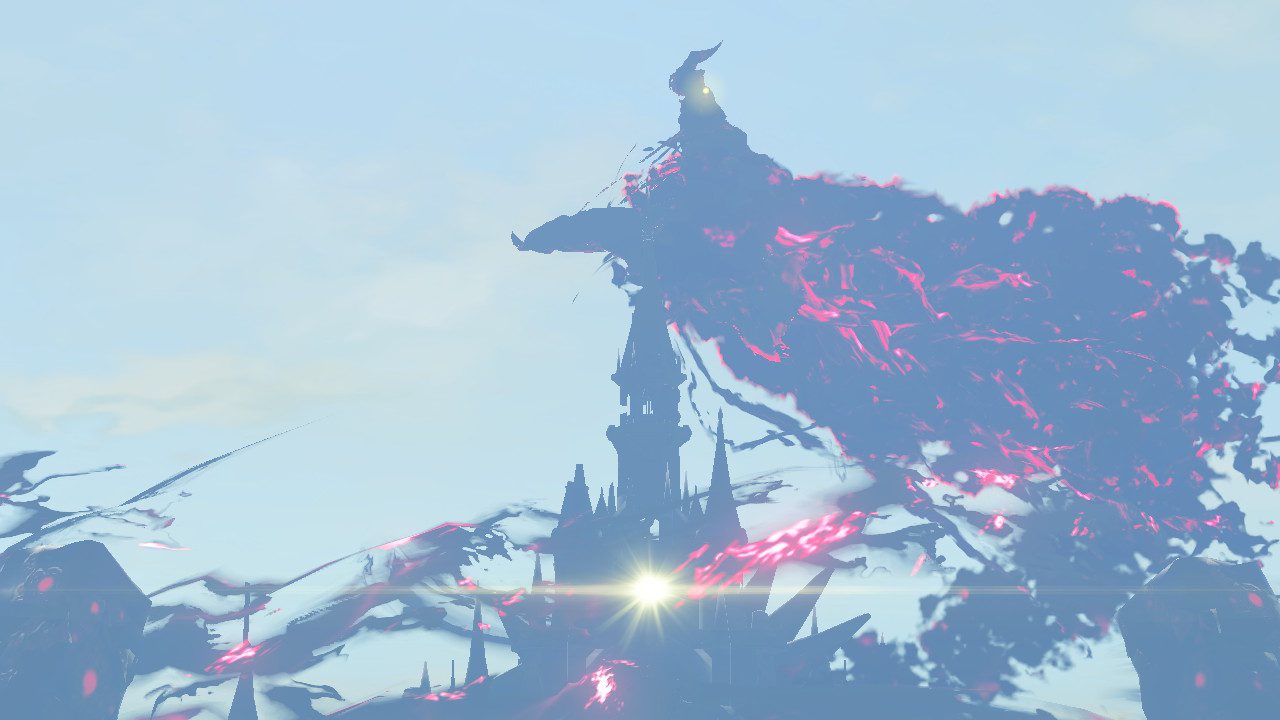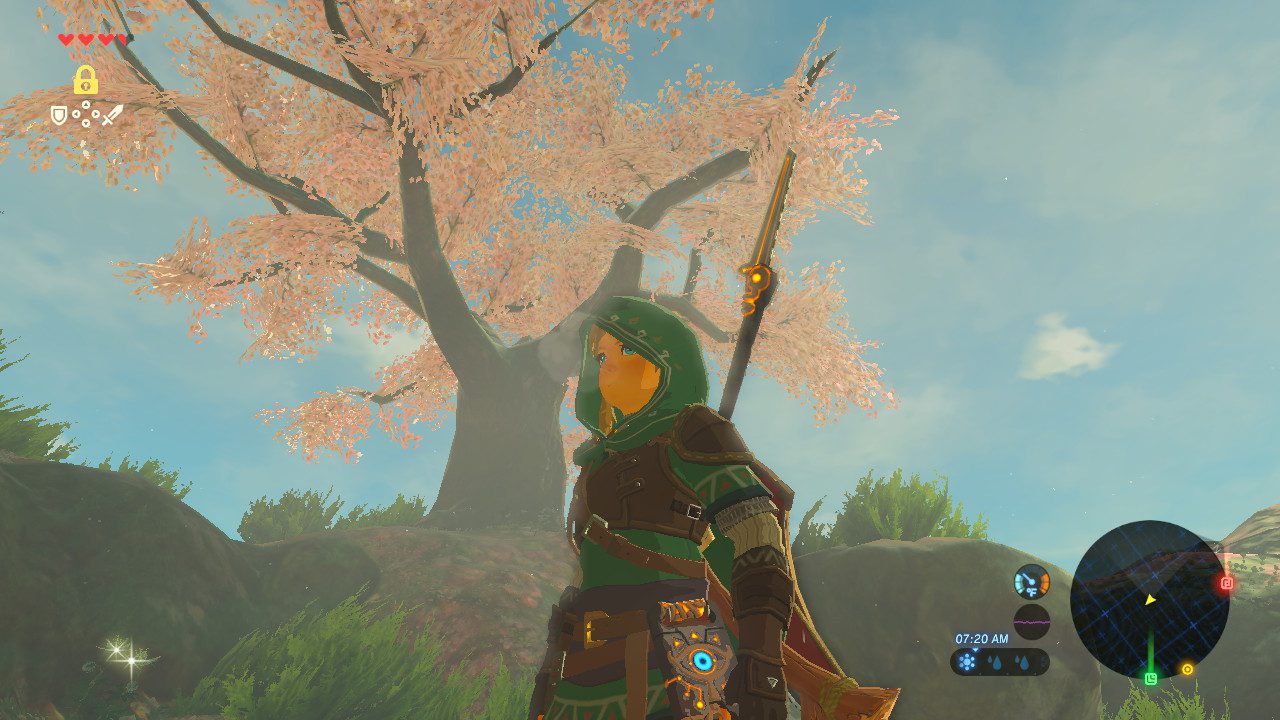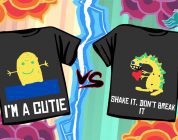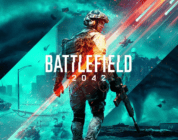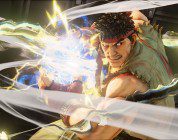After spending most of this month obsessing over the latest entry into the massively loved Legend of Zelda series, I can no honestly give my thoughts about Breath of the Wild. This was the game that solidified my want of the Nintendo Switch, especially since I could take the experience wherever I happen to be. Zelda has been such a prominent piece of media in my life, one that sparked many friendships, late nights, and discussions about the convoluted connected stories. It’s a series that practically shaped my very being. I have always related to Miyamoto’s inspiration of exploring the forests, as I grew up wandering the woods and swinging sticks at imaginary goblins. This being said, I went in a bit skeptic as a long time fan. Where does Breath of the Wild fit into this iconic legacy?
Breath of the Wild seems like a bit of a risk when explained in its simplest terms. This Zelda game is an open world adventure, one that in which the player is only given a few major goals and are free to explore the vast world at their own leisure. This is a game that takes some of the tropes established by open world trend setters, like Assassin‘s Creed’s towers, Far Cry‘s enemy camps, and Skyrim‘s dense points of interest. This is all held together by an actual physics system, which is a real first for the series.
Once again, this is something that had many longtime fans skeptic, including myself. Many of those tropes have become tiresome due to their sheer prevalence in the AAA space. Yet, Nintendo has taken the time and effort to present this huge, beautiful world in a way that is inviting and thought provoking.
The land of Hyrule has never felt so realized. Link can walk from one end of this world to the other without a single loading frame, provided he doesn’t fast travel or perish in some way. Simply traveling through Hyrule is enjoyable, and this may be due to the fact that this is a surprising take for Zelda, but even without the weight of the name, this would be an amazing open world game, or so it seems to be. This is a world that doesn’t ask the player to meet mission requirements or simply check off a long list of collectibles. The game starts in the tutorial area to grant the player all the tools they’ll need and then lets them loose, a pleasant surprise due to the amount of hand-holding seen in game design within the last couple generations.
The brilliance of this starting area should be mentioned as well. The game starts with Link waking up in a strange chamber, with glowing technology trimming the room. Here, he picks up the most important item in the game, the Sheikah Slate, a tablet that will do everything from being a map to being able to stop objects in time. Once the slate is acquired, Link is led by a mysterious voice out of the cave, where he is met with the horizon of Hyrule. The natural downward slope outside of the cave, as well as the smoke billowing from a nearby campfire is enough subconscious incentive to lead the player to the Old Man, a character that will feel familiar to long time fans of the series. I was surprised this Old Man didn’t mention anything about it being dangerous to go alone.
From the Old Man, Link is pointed to the four shrines littered throughout the plateau, offering Link the paraglider upon completion. In each of these shrines is an ability, which gives Link all the abilities he’ll need to solve almost every puzzle in the game. Once these mini puzzles are complete, Link must go to the dilapidated Temple of Time to learn of the state of Hyrule and the terror of Calamity Ganon. Here we learn that Link has been asleep for 100 years and must pick up his blade once again to finally put an end to the suffering by confronting Ganon once more.
This misplacement in time is how the player is given context for the drama at work. Breath of the Wild is by no means a story that is presented in a linear fashion like many other Zelda games. No, this adventure is all about the relationships Link made in the past and their effects on the present. Some characters, like the Zora people, actually remember meeting Link long ago. Unfortunately, Link has no recollection of the past, being a blank slate for the player to mold and learn more about. Most of the game’s stories are presented as objects or scenery that sparks a sudden memory in Link, which is often presented as a cutscene with emotionally charged voice acting.
I’ll admit, it’s a little strange to hear actual voices coming from these characters, especially given that the Legend of Zelda series has rarely dabbled in such. However, I can honestly say that this has been some of the most deliberate and powerful performances I have heard in a long time. Zelda’s voice is incredibly beautiful, given an almost British or Irish depth. Even though Zelda isn’t actually found for quite some time, these memories show the deep connection Link and Zelda have for each other. After only a few memories being found, I knew that I wanted to save her, more so than ever before. Her character is much more regal, being a figure that all of Hyrule stands behind. Link isn’t really the main character in this story, Zelda is. Not only that, but these moments are often drenched in sadness for what Hyrule has become, a lamenting of what has been lost in this war against Ganon.
Mark Brown, producer of Game Maker’s Toolkit recently used an excellent word to describe Breath of the Wild‘s overall tone, melancholy. While his focus was on the music of Breath of the Wild in that piece, at almost every level, Breath of the Wild is a melancholy, a work of tragedy.
Sure, Hyrule offers beautiful vistas from its plethora of high vantage points, but the sadness of knowing there used to be so much more really starts to hit home the deeper the player gets into the game. I found myself smiling less at the sunrise and feeling more and more determined to finish what was started a hundred years ago, feeling the weight of a hero on my shoulders. The goal isn’t as simple as going through the dungeons to get the pieces that beat the final boss, every single action is about building enough strength, resources, and knowledge to tackle a tremendous force of nature.
Often in Zelda, an orchestral swell leads the charge, but this isn’t so in Breath of the Wild. Most of Breath of the Wild‘s soundtrack is built upon a piano driven foundation, one that does use melodies from past Zelda games, but only deliberately and with care. Each major settlement of the game has its own memorable theme, changing pitch or adding layers during different times of day or when new events occur. Really its the lack of music that helps define Breath of the Wild, leaving the player to their own thoughts and hearing the wildlife, wind, or the distant grunts of monsters. This game puts the natural world on the center stage and the soundtrack does its best to not detract from that.
Knowing what’s in the distance is an important aspect of playing Breath of the Wild. I’m not really sure how this works at the programming level, seeing that objects do render upon proximity like most games, but the player can actually see points of interest from miles away and can clearly interpret what they are. This is mostly done with color, as places that are untouched by Link often glow orange, while places already visited glow blue. Yet, there are many moments when Link can actually see massive creatures and machines moving in the distance, clearly able to tell its gait and see plenty of detail. Approaching these huge creatures is awe-inspiring, reminding me most of the use of scale in Shadow of Colossus. The four gigantic machines known as the Divine Beasts are the greatest example of this. I actually turned off the four goal points on the mini map, opting to explore the world myself without clear direction, only to see the Gerudo Desert’s Divine Beast stomping around and creating a sand storm from a far off mountaintop. Seeing this machination literally affecting nature created a sense of wonder and fear in me, coaxing me to move closer to learn more.
These four Divine Beasts were once the ultimate weapons created by the people of Hyrule to combat Calamity Ganon. Inside these machines are the four main dungeons of the game. While most of the puzzles are solvable within fifteen minutes or so in the Shrines, these dungeons are more akin to the classic set up of past Zelda titles, although much shorter. Getting inside of these Divine Beasts is typically prefaced with an epic face off to stall the machine. After this is complete, Link is given access to the inside, where he must banish the corruption to acquire control. These areas feel like a giant puzzle box, slowly unraveling the solution using all the techniques learned so far. There is also a more traditional boss fight at the end of each dungeon, an embodiment of the corruption spread by Calamity Ganon.
Traveling to and from these dungeons is where Zelda shines as an open world game. Movement and how the player gets around is a huge part of creating these worlds. In Grand Theft Auto, this is typically a car or a helicopter, but for Breath of the Wild there is an assortment of tools and moves to make traveling a treat. For starters, players are given the paraglider early on, giving Link the ability to soar long distances or use updrafts to get more verticality. Link can also use his shield as a surfboard to travel quickly downhill, which is especially fun in the desert and on the rolling hills. Horses can also be caught and tamed, even letting players customize their ride with different manes and saddles. Aside from horses, Link can also mount other creatures including a bear! Don’t expect the stables to take it in though.
Combining all these elements, a skilled player can move about Hyrule in a fluid way that never ceases to be fun. To help give movement more of an edge in combat, a slowdown effect occurs after jumping off a horse or while paragliding and knocking an arrow. This lets the player tackle combat in various ways, which is a must considering just how brutal the game can be. Link is rarely safe, with even the lowliest of baddies being able to slap him around. Everything in Hyrule will kill Link, from high falls, assassins that are obsessed with bananas, or even lightning strikes. Honestly, I haven’t died this much in a game since Dark Souls, leading me to believe that Aonuma and his team are a fan of From Software’s flagship series.
Combat is more about having the right resources and using the environment well. Weapons break over time, meaning the player can’t really stick with a single play style. Even though this can become frustrating for a lot of players, I found this system to be a way to force me into new strategies. Instead of running in and swinging the biggest sword I had, I often surveyed the area from afar to decide if I should shoot an explosive barrel or sneak up for instant kills. Yet, when in close combat, it always felt more like chess. I often had to read my enemies moves and react to them in whatever way seemed best, whether that’s a well placed strike, a clever dodge, or a risky parry. Larger foes will require a ton more preparation though, which is where cooking comes in.
Cooking is how Link is able to heal himself, as he is only able to refill his hearts from meals instead of the random drops of games prior. The combination of ingredients used is what creates various effects like added damage or defense or increased resistance to weather conditions just to name a few. Not only can Link cook stellar (or dubious if failed) meals, but elixirs can also be crafted with insects and monster parts. Seeing as most objects and creatures drop items or can be gathered, many items also have multiple effects. One of the earliest examples of this is flint, which can be laid next to a pile of wood or a dead campfire, struck with a metal weapon, and sparked to create a quick campfire. Later on, I came to learn that Octorok Balloons can make things float, which can be combined with a raft to make an airship. There are so many crazy applications of the game’s items that experimentation is not only incentivized, but wildly fun.
Zelda staples and iconic aspects do litter the world of Breath of the Wild. It’s awesome so see the Lynels be reimagined as powerful forces, even looking a bit like Ganon’s more bestial forms. Keese, Zelda’s bats, now can travel in dangerous swarms. Zoras each now have resemblance to other sea life, like sharks or manta rays. Each part of the familiar elements of what makes a Zelda game have been reworked into a new form, one that encapsulates what made them iconic to begin with, while providing the world with a rich ecosystem of characters and creatures. There is one element that has been lost between games though.
Ganon is no longer the conniving lord of the Gerudos, usually being everything that Link lacked with a larger physique and imposing political standing. For Breath of the Wild, Link and all of Hyrule is against the evil force of nature that is Calamity Ganon. This powerful monster darkens the sky and coils around Hyrule Castle like a sinister serpent. Gone are the days of monologues, as Ganon is now just a tremendous element to overcome. Although, never before has Ganon felt so powerful, requiring a combined effort of all of Hyrule to even stand a chance against it. Yet, I can’t help but feel a bit sad at the loss of Ganon’s character as a whole, one that has seen some truly epic development over the years. Now, more than ever, Ganon is the embodiment of darkness in the world.
I will say that after over fifty hours, I feel like I’ve barely scratched the surface of what Breath of the Wild has to offer. Even now, I find the dangerous task of taking on Ganon so daunting that I would rather explore more the world, biding my time and building my power. Even once I reach that point though, I doubt I’ll want this adventure to end with my only motivation being my deep desire to save Zelda. I do look forward to that final battle against Calamity Ganon as a desperate cry of defiance from all of Hyrule, especially from Link who has already failed his kingdom once.
Do I consider Breath of the Wild to be the best game ever or even best in the series? It’s hard to tell right now. Many, many other reviewers have given Breath of the Wild a perfect score and I’m inclined to follow in their footsteps. This is a game that hits all the right chords of nostalgia that I’ve built over the years. I’ve always wanted a Zelda game like this, but years from now after the excitement wanes, I want to know what I’ll think then. I still consider Link to the Past to be a masterpiece in every sense of the word, closely followed by Link’s Awakening. Yet, many consider Ocarina of Time a pinnacle for gaming as a whole. Where will Breath of the Wild fall ten years from now? It’s that level of reflection that I look forward to discussing later on.
Breath of the Wild is, without a shadow of a doubt, an experience that all players should experience. There are simply too many positive elements compared to the sparse negative ones, overcasting any problems with the sheer enjoyment I’ve had in playing the game. Surely, I’ll be playing this game regularly for years to come. Legend of Zelda: Breath of the Wild carries the legacy well, making it an instant classic.



